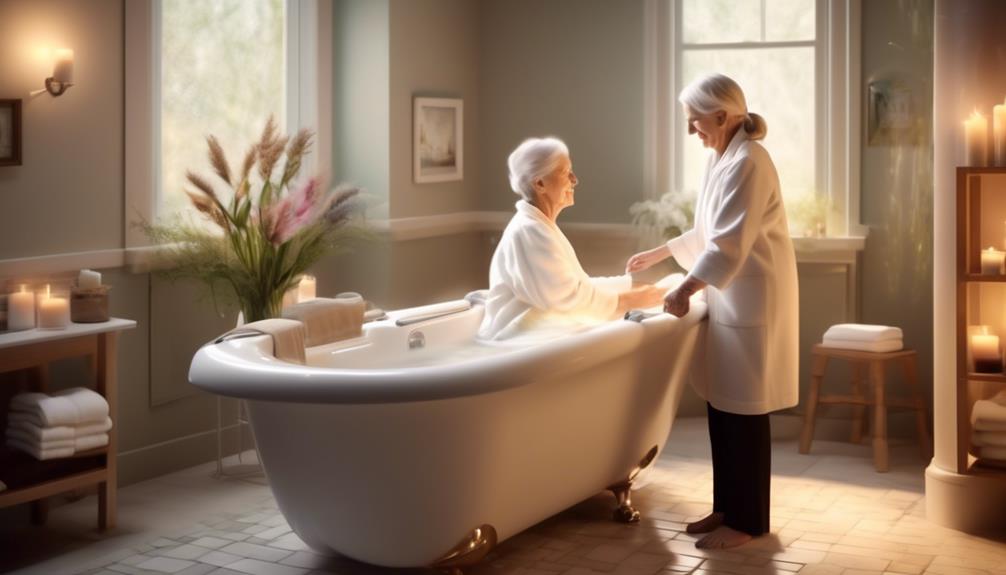Research indicates that approximately 90% of individuals with dementia exhibit behavioral challenges, like agitation while bathing, highlighting the importance of incorporating compassionate care strategies in these routine tasks.
Understanding the unique challenges that arise when assisting someone with dementia in bathing is essential for providing dignified and effective care. By exploring tailored approaches, fostering trust through communication, and prioritizing the individual's comfort, caregivers can navigate these challenges with empathy and respect.
Let's explore how incorporating these strategies can significantly impact the well-being of individuals with dementia and enhance their quality of life.
Key Takeaways
- Modify environment for comfort
- Use gentle communication techniques
- Explore alternative bathing approaches
- Prioritize dignity in after-bath care
Understanding Bathing Challenges in Dementia
Understanding the complexities of bathing challenges in dementia can shed light on the struggles individuals face daily. Dementia patients may experience sensory overload, leading to resistance during bathing. This resistance can stem from fear of water, forgetfulness, or embarrassment.
To address these challenges with compassion, creative strategies such as using familiar soaps or playing soothing music can help create a more comfortable bathing experience. Establishing routines and respecting privacy are essential in maintaining dignity while empowering individuals by offering choices can increase their sense of control.
Creating a Calm Bathing Environment

To create a calm bathing environment for individuals with dementia, consider modifying the bathroom with soothing colors and soft lighting to reduce agitation. Incorporating gentle touches, playing soothing music, and using fragrance-free products can further enhance the bathing experience for dementia patients. An organized space free of clutter can promote feelings of safety and security, helping to alleviate any potential distress during the bathing process. Additionally, sticking to a consistent routine and schedule can provide predictability and comfort, reducing anxiety and resistance in individuals with dementia. By creating a serene atmosphere with calming colors, soft lighting, and familiar sounds, caregivers can help make the bathing experience more pleasant and manageable for those with dementia. Below is a table summarizing key strategies for creating a calm bathing environment for dementia patients:
| Strategies | Benefits | Implementation |
|---|---|---|
| Calming colors | Reduce agitation | Paint walls in soothing tones |
| Soft lighting | Create a relaxing atmosphere | Install dimmable lights |
| Fragrance-free products | Prevent sensory overload | Select unscented toiletries |
| Consistent routine | Provide predictability | Establish a set bathing schedule |
| Organized space | Enhance feelings of safety | Declutter and organize bathroom |
Gentle Communication Techniques for Bathing
As we continue to enhance the bathing environment for individuals with dementia by creating a serene atmosphere, gentle communication techniques play a crucial role in ensuring a comfortable and positive bathing experience.
When engaging with dementia patients during bathing, it's essential to use clear and simple language to explain the process, maintaining a calming tone throughout. Providing step-by-step instructions can help guide them through each task, reducing anxiety and confusion.
Rushing should be avoided, as it can lead to resistance and discomfort. Encouraging participation and offering choices empower individuals, giving them a sense of control and dignity in the process.
Exploring Alternative Bathing Approaches

Exploring alternative bathing approaches can offer individuals with dementia more comfortable and tailored care options to enhance their bathing experience and overall well-being. It is crucial to consider the unique challenges faced by a person with dementia when it comes to bathing routines. Implementing alternative methods such as sponge baths or utilizing non-rinse soap products can significantly simplify the bathing process and make it a more manageable task for both the caregiver and the individual. By adjusting bathing standards to meet individual needs and preferences, we can ensure that the person's comfort levels are prioritized throughout the bathing experience. Tailoring the bathing routine to suit the specific requirements of dementia patients can help create a more calming and enjoyable atmosphere during this essential daily activity. Embracing these alternative approaches allows us to provide dignified and respectful care while promoting the well-being of those we serve.
| Alternative Bathing Methods | Simplify Bathing Process | Tailored to Individual Needs |
|---|---|---|
| Sponge Baths | Washing Different Body Parts on Different Days | Adjusting Bathing Standards |
| Non-Rinse Soap Products | Shampooing Hair Separately or on Alternate Days | Tailoring Bathing Routines |
Dignified After-Bath Care Practices
After exploring alternative bathing approaches to enhance the bathing experience for individuals with dementia, it's essential to shift our focus to dignified after-bath care practices to ensure their comfort and well-being are maintained.
- Checking for skin issues: After bathing, inspect for rashes and sores, particularly in incontinent individuals, to prevent skin problems.
- Seated drying and dressing: Ensure the individual is comfortably seated during the drying and dressing process to maintain stability and comfort.
- Thorough drying: Pay special attention to drying thoroughly, especially between the toes, to prevent moisture-related skin issues.
- Moisturizing: Apply lotion post-bath to maintain soft skin and prevent dryness, a common issue in elderly individuals.
- Powder application: Use cornstarch or talcum powder in skin folds and under breasts to prevent irritation and discomfort.
These after-bath care practices not only promote physical well-being but also contribute to the individual's dignity and overall sense of comfort.
Frequently Asked Questions
How Do You Provide Compassionate Care to Dementia Patients?
When caring for dementia patients, we focus on compassion by maintaining a calm demeanor, offering choices, and using clear communication.
By involving individuals in the bathing process, we empower them and show respect for their dignity.
Providing reassurance, praise, and tailored care strategies ensures a positive experience.
Our goal is to create a compassionate environment that honors each person's preferences and needs throughout the care routine.
How Do You Encourage a Dementia Patient to Bathe?
When it comes to encouraging a dementia patient to bathe, we find that establishing a routine and creating a comfortable, familiar environment can work wonders.
By offering clear instructions, maintaining good lighting, and respecting their dignity, we can help them feel more at ease. It's all about understanding their preferences and adapting the bathing process to suit their needs.
With patience and compassion, we can navigate this challenge with empathy and respect.
What Are Coping Strategies for Dementia Patients?
When coping with dementia patients, we focus on creating a supportive environment.
We encourage independence, offer positive reinforcement, and adapt routines to match preferences.
Distraction techniques like music and conversation help reduce anxiety.
Patience, empathy, and understanding are key to building trust.
What Specific Interventions Might Be Helpful in Promoting Comfort During a Bath for Persons With Dementia?
When it comes to promoting comfort during a bath for persons with dementia, we focus on creating a soothing environment that minimizes stress and enhances their sense of control.
Incorporating warm water, familiar scents, and music can evoke positive memories, while offering choices and maintaining a person-centered approach empowers individuals.
Proper lighting, step-by-step instructions, and visual cues all contribute to clarity and independence during bathing activities.
Our goal is to ensure their comfort and dignity throughout the process.
Conclusion
As caregivers, we understand the challenges of bathing individuals with dementia. By creating a calm environment, using gentle communication, exploring alternative approaches, and practicing dignified after-care, we can navigate these challenges with compassion.
Remember, each person is unique, and adapting our strategies to meet their needs is key. With patience, understanding, and a willingness to try new techniques, we can provide the best care possible for our loved ones with dementia. Remember, each person is unique, and adapting our strategies to meet their needs is key. With patience, understanding, and a willingness to try new techniques, we can provide the best care possible for our loved ones with dementia. Embracing a person-centered approach in dementia care allows us to focus on their individual preferences, histories, and abilities, creating a more meaningful connection. This approach fosters dignity and respect, helping to enhance their quality of life while easing the challenges both caregivers and individuals may face.









